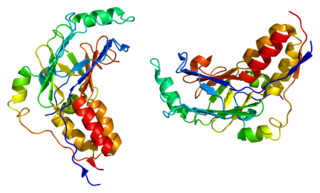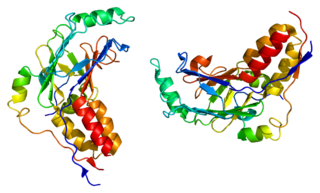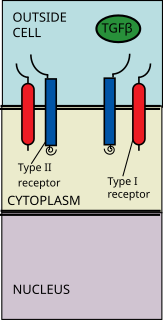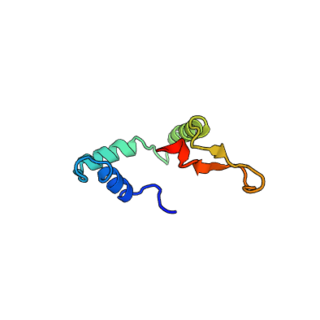The DAF-2 gene encodes for the insulin-like growth factor 1 (IGF-1) receptor in the worm Caenorhabditis elegans. DAF-2 is part of the first metabolic pathway discovered to regulate the rate of aging. DAF-2 is also known to regulate reproductive development, resistance to oxidative stress, thermotolerance, resistance to hypoxia, and resistance to bacterial pathogens. Mutations in DAF-2 have been shown by Cynthia Kenyon to double the lifespan of the worms. In a 2007 episode of WNYC’s Radiolab, Kenyon called DAF-2 "the grim reaper gene.”
Dauer describes an alternative developmental stage of nematode worms, particularly rhabditids including Caenorhabditis elegans, whereby the larva goes into a type of stasis and can survive harsh conditions. Since the decision to enter the dauer stage is dependent on environmental cues, it represents a classic and well studied example of polyphenism. The dauer state is given other names in the various types of nematodes such as ‘diapause’ or ‘hypobiosis’, but since the C. elegans nematode has become the most studied nematode, the term ‘dauer stage’ or 'dauer larvae' is becoming universally recognised when referring to this state in other free-living nematodes. The dauer stage is also considered to be equivalent to the infective stage of parasitic nematode larvae.

Transforming growth factor beta (TGF-β) is a multifunctional cytokine belonging to the transforming growth factor superfamily that includes three different mammalian isoforms and many other signaling proteins. TGFB proteins are produced by all white blood cell lineages.

Mothers against decapentaplegic homolog 2 also known as SMAD family member 2 or SMAD2 is a protein that in humans is encoded by the SMAD2 gene. MAD homolog 2 belongs to the SMAD, a family of proteins similar to the gene products of the Drosophila gene 'mothers against decapentaplegic' (Mad) and the C. elegans gene Sma. SMAD proteins are signal transducers and transcriptional modulators that mediate multiple signaling pathways.

Mothers against decapentaplegic homolog 3 also known as SMAD family member 3 or SMAD3 is a protein that in humans is encoded by the SMAD3 gene.

SMAD4, also called SMAD family member 4, Mothers against decapentaplegic homolog 4, or DPC4 is a highly conserved protein present in all metazoans. It belongs to the SMAD family of transcription factor proteins, which act as mediators of TGF-β signal transduction. The TGFβ family of cytokines regulates critical processes during the lifecycle of metazoans, with important roles during embryo development, tissue homeostasis, regeneration, and immune regulation.

SMAD family member 6, also known as SMAD6, is a protein that in humans is encoded by the SMAD6 gene.
R-SMADs are receptor-regulated SMADs. SMADs are transcription factors that transduce extracellular TGF-β superfamily ligand signaling from cell membrane bound TGF-β receptors into the nucleus where they activate transcription TGF-β target genes. R-SMADS are directly phosphorylated on their c-terminus by type 1 TGF-β receptors through their intracellular kinase domain, leading to r-SMAD activation.
Smads comprise a family of structurally similar proteins that are the main signal transducers for receptors of the transforming growth factor beta (TGF-B) superfamily, which are critically important for regulating cell development and growth. The abbreviation refers to the homologies to the Caenorhabditis elegans SMA and Drosophila MAD family of genes.
The transforming growth factor beta (TGFB) signaling pathway is involved in many cellular processes in both the adult organism and the developing embryo including cell growth, cell differentiation, apoptosis, cellular homeostasis and other cellular functions. In spite of the wide range of cellular processes that the TGFβ signaling pathway regulates, the process is relatively simple. TGFβ superfamily ligands bind to a type II receptor, which recruits and phosphorylates a type I receptor. The type I receptor then phosphorylates receptor-regulated SMADs (R-SMADs) which can now bind the coSMAD SMAD4. R-SMAD/coSMAD complexes accumulate in the nucleus where they act as transcription factors and participate in the regulation of target gene expression.

The SKI protein is a nuclear proto-oncogene that is associated with tumors at high cellular concentrations. SKI has been shown to interfere with normal cellular functioning by both directly impeding expression of certain genes inside the nucleus of the cell as well as disrupting signaling proteins that activate genes.

The upstream signaling pathway is triggered by the binding of a signaling molecule, a ligand, to a receiving molecule, a receptor. Receptors and ligands exist in many different forms, and they will only recognize/bond particular molecules. Upstream extracellular signaling transduce an endless variety of intracellular cascades.

Forkhead box protein H1 is a protein that in humans is encoded by the FOXH1 gene.

DAF-16 is the sole ortholog of the FOXO family of transcription factors in the nematode Caenorhabditis elegans. It is responsible for activating genes involved in longevity, lipogenesis, heat shock survival and oxidative stress responses. It also protects C.elegans during food deprivation, causing it to transform into a hibernation - like state, known as a Dauer. DAF-16 is notable for being the primary transcription factor required for the profound lifespan extension observed upon mutation of the insulin-like receptor DAF-2. The gene has played a large role in research into longevity and the insulin signalling pathway as it is located in C. elegans, a successful ageing model organism.
The DAF-1 gene encodes for a cell surface Enzyme-linked receptor of TGF-beta signaling pathway in the worm Caenorhabditis elegans. DAF-1 is one of the type I receptor of TGF-beta pathway. DAF-1 acts as a receptor protein serine/threonine kinase, is activated by type II receptor Daf-4 phosphorylation after the ligand Daf-7 binds to the receptor heterotetramer, and then phosphorylates Daf-8 or Daf-14, the SMAD proteins in C. elegans.
The DAF-4 gene encodes for the only type II receptor of TGF-beta signaling pathway in the worm Caenorhabditis elegans, with the ligands Daf-7 or Dbl-1. When binds to the ligand Daf-7, Daf-4 complexed with the type I receptor Daf-1, and activated the Smad Protein Daf-8/14. By contrast, when binds to Dbl-1, Daf-4 complexed with the Sma-6 type I receptor, and activated the Sma-2/3/4.
The DAF-7 gene encodes for the ortholog of GDF11, a ligand of TGF-beta signaling pathway, in the worm Caenorhabditis elegans. When binds to the complex of type II receptor Daf-4 and type I receptor Daf-1, this receptor protein serine/threonine kinase will phosphorylation activate the Smad Protein Daf-8/14.
The DAF-8 nematode gene encoding a R-SMAD protein of TGF-beta signaling pathway, which was originally found in model organism Caenorhabditis elegans. When the TGF-β ligand daf-7 binds to the TGF-β receptors daf-1/daf-4 on the surface of nematode cell, daf-8 will be phosphorylated and forms a heterodimer with daf-14, then enter to the nucleus to inhibit transcription regulated by daf-3/daf-5.
The DAF-14 is a nematode Caenorhabditis elegans gene encoding a R-SMAD protein of TGF-beta signaling pathway, which will be phosphorylated and forms a heterodimer with phosphorylated daf-8 when the TGF-β ligand daf-7 binds to the TGF-β receptors daf-1/daf-4, then the heterodimer enter to the nucleus to inhibit transcription regulated by daf-3/daf-5.
Daf-5 is an ortholog of the mammalian protein Sno/Ski,which present in the nematode worm Caenorhabditis elegans on the downsteam of TGFβ signaling pathway. Without daf-7 signal, daf-5 combined with daf-3, co-SMAD for C. elegans, to form a heterodimer and started dauer development.








